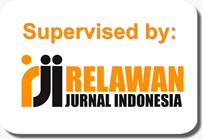A THEORETICAL MODEL FOR THE CROSS SECTION OF THE LIQUIDITY, FIRM SIZE, EARNINGS VOLATILITY, AND LEVERAGE IN INDONESIA
Abstract
Full Text:
PDFReferences
Alib, Y. A. (2014). Pengaruh Struktur Aset, Profitabilitas, Growth Dan Size Terhadap Struktur Modal Pada Perusahaan Otomotif, 3(1), 1–17.
Cahyani, N. I. (2017). Pengaruh Profitabilitas , Likuiditas , Size , Kepemilikan Institusional , Dan Tangibility Terhadap Struktur Modal, 6.
Fahmi, I. (2016). Pegantar Manajmen Keuangan (5th Ed.).
Fahmi, L. Z. U. L. (2017). Pengaruh Struktur Aktiva, Ukuran Perusahaan, Dan Likuiditas Terhadap Struktur Modal Luthfillah Zul Fahmi. Jurnal Ilmu Dan Riset Akuntansi Volume 6, Nomor 2, Februari 2017, 6(Issn : 2460-0585).
Firnanti, F. (2011). Faktor-Faktor Yang Mempengaruhi Struktur Modal Perusahaan Manufaktur. Jurnal Bisnis Dan Akuntansi, 13(2), 119–129.
Hidayat, M. S. (2013). Pengaruh Kepemilikan Manajerial, Kebijakan Dividen, Struktur Aktiva, Pertumbuhan Penjualan, Dan Ukuran Perusahaan Terhadap Kebijakan Utang. Jurnal Ilmu Manajemen, 1.
Maulia, H. (2015). Analisis Pengaruh Profitabilitas, Struktur Aset, Likuiditas, Dan Pertumbuhan Penjualan Terhadap Struktur Modal. Jurnal Ilmu & Riset Akuntansi Vol. 4 No. 7 (2015), 4(7).
Prihadi, T. (2008). 7 Analisis Rasio Keuangan.
Putri, M. E. D. (2012). Pengaruh Profitabilitas, Struktur Aktiva Dan Ukuran Perusahaan Terhadap Struktur Modal Pada Perusahaan Manufaktur Sektor Industri Makanan Dan Minuman Yang Terdaftar Di Bursa Efek Indonesia (Bei), 1(September), 1–10.
Ririt, A. (2017). Pengaruh Ukuran Perusahaan, Pertumbuhan Penjualan, Profitabilitas, Struktur Aktiva, Likuiditas Terhadap Struktur Modal. Jurnal Ilmu Dan Riset Akuntansi Volume 6, Nomor 3, Maret 2017, 6(Issn : 2460-0585), 1268–1289.
Sari, A. N. (2016). Pengaruh Profitabilitas, Likuiditas, Pertumbuhan Aset Dan Ukuran Perusahaan Terhadap Struktur Modal, 5(April), 1–18.
Sugiyono, P. D. (2017). Metode Penelitian Bisnis. (M. S. Sofia Yustiani Suryandari, S.E., Ed.) (3rd Ed.). Bandung: Alfabeta, Cv.
Winarno, Wing Wahyu. (2015). Analisis Ekonometrika Dan Statistika Dengan Eviews (4th Ed.). Yogyakarta: Upp Stim Ykpn.
Windraesti, J. A. (2012). Pengauh Kerakteristik Perusahaan Terhadap Struktur Modal : Studi Empiris Di Bursa Efek. Jrak, 8.
Wulandari, N. (2017). Analisis Faktor-Faktor Yang Mempengaruhi Inflasi Pada Kota Metropolitan Di Indonesia Dengan Menggunakan Analisis Data Panel, 3(2), 34–42.
Yeo, H. (2016a). Solvency And Liquidity In Shipping Companies. Asian Journal Of Shipping And Logistics, 32(4), 235–241. Https://Doi.Org/10.1016/J.Ajsl.2016.12.007
Yeo, H. (2016b). The Asian Journal Ofpengiriman Dan Logistik, 32(4).
Yusra, I., Hadya, R., & Egawati, N. (2017). Analisis Efektivitas Pengendalian Biaya, Perputaran Modal Kerja, Dan Rentabilitas Ekonomi Menggunakan Regresi Data Panel. Jurnal Pundi, Vol. 01, No. 03, November 2017 Analisis, 1(3), 153–166.
DOI: https://doi.org/10.31846/jae.v7i3.238
Refbacks
- There are currently no refbacks.

This work is licensed under a Creative Commons Attribution-NonCommercial-NoDerivatives 4.0 International License.
e-Jurnal Apresiasi Ekonnomi Indexed by:












